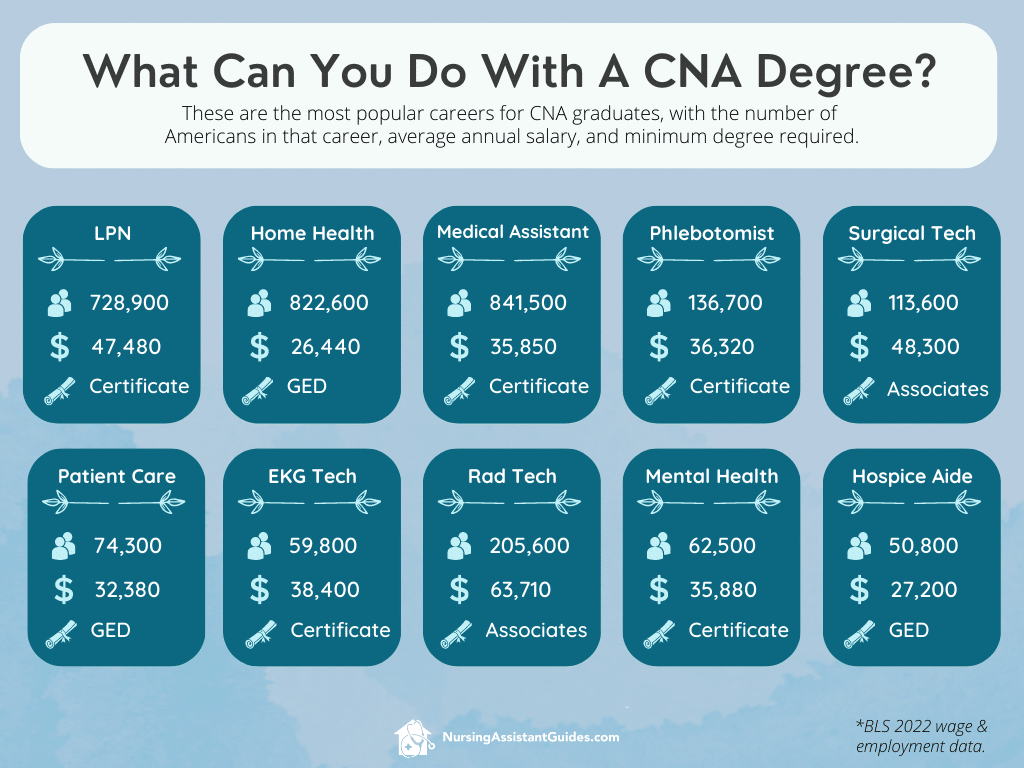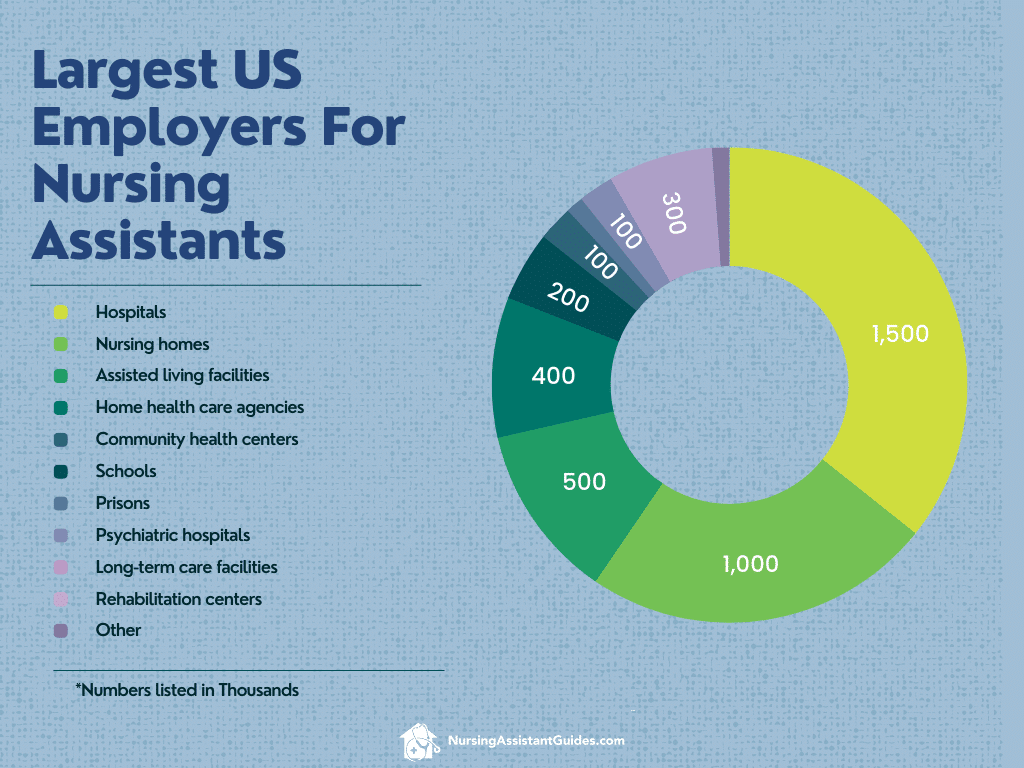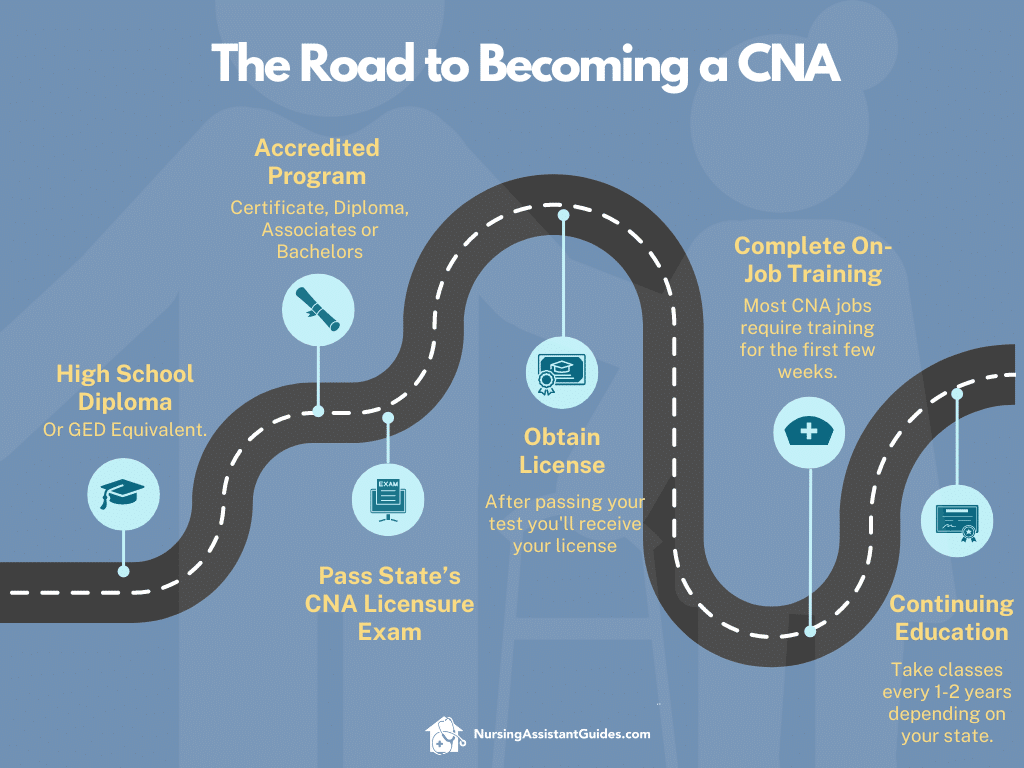
CNA Careers
More Answers From Certified Nursing Assistants
4 Steps To Becoming A CNA
Step 1
Get Your Degree
Get a certificate, associates, or bachelors in nursing assisting or a related field.
Step 2
Clinical Rotation
A required supervised internship in a healthcare setting.
Step 3
Certification Exam
For most states, the CNA exam is administered by the NCSBN.
Step 4
Get State License
Apply with proof of your degree, clinical experience and exam.
Best Online CNA School Programs
There are multiple levels of CNA programs available. The most common is a CNA certificate program, which typically takes about 12 weeks to complete. CNA certification programs are offered at community colleges, vocational schools and via online colleges. There are also associate in nursing assistant degrees, which typically take about two years to complete. Associate degree programs are offered at online colleges, community colleges and some technical schools. Here is a list of accredited online CNA school programs:
Nursing Assistant Career Overview
What Can You Do With A CNA Degree?
Becoming a CNA opens you up to a wide variety of potential careers as well as future degrees which will further advance your career. Here are some of the most common careers that you can pursue with a CNA degree, along with brief descriptions, estimated employment figures in the United States, and approximate annual salary ranges:
- Licensed Practical Nurse (LPN): Provide basic medical care under the supervision of registered nurses; approximately 728,900 LPNs are employed in the US with a median annual wage of $47,480.
- Registered Nurse (RN): Provide direct patient care, administer medications, and coordinate treatment plans; there are around 3,059,800 RNs in the US with a median annual wage of $75,330.

- Medical Assistant: Support healthcare professionals with administrative and clinical tasks; around 841,500 medical assistants are employed in the US with a median annual wage of $35,850.
- Phlebotomist: Collect blood samples from patients for medical testing and donation purposes; there are around 136,700 phlebotomists in the US with a median annual wage of $36,320.
- Surgical Technologist: Assist in surgical operations by preparing operating rooms and maintaining equipment; approximately 113,600 surgical technologists are employed in the US with a median annual wage of $48,300.
- Patient Care Technician: Provide direct patient care, monitor vital signs, and assist with daily activities; there are around 74,300 patient care technicians in the US with a median annual wage of $32,380.
- Medical Secretary: Perform administrative tasks such as scheduling appointments, managing patient records, and handling billing; approximately 601,700 medical secretaries are employed in the US with a median annual wage of $38,390.
- EKG Technician: Operate electrocardiogram (EKG) equipment to measure and record patients’ heart activity; there are around 59,800 EKG technicians in the US with a median annual wage of $38,400.
- Pharmacy Technician: Assist pharmacists in dispensing medications and managing pharmacy operations; approximately 415,500 pharmacy technicians are employed in the US with a median annual wage of $34,020.
- Dental Assistant: Provide chairside assistance to dentists and perform various dental procedures; there are around 358,800 dental assistants in the US with a median annual wage of $40,080.
- Physical Therapy Assistant: Help physical therapists provide treatment and rehabilitation to patients; approximately 103,200 physical therapy assistants are employed in the US with a median annual wage of $51,040.
- Occupational Therapy Assistant: Aid occupational therapists in helping patients develop, recover, or improve skills needed for daily living; there are around 47,800 occupational therapy assistants in the US with a median annual wage of $61,510.
- Radiologic Technologist: Operate imaging equipment to perform X-rays, CT scans, and other diagnostic tests; approximately 205,600 radiologic technologists are employed in the US with a median annual wage of $63,710.
- Respiratory Therapist: Evaluate and treat patients with breathing or cardiopulmonary disorders; there are around 136,100 respiratory therapists in the US with a median annual wage of $63,950.
- Medical Billing and Coding Specialist: Assign codes to medical procedures and manage healthcare billing processes; approximately 360,000 medical records and health information technicians (including coding specialists) are employed in the US with a median annual wage of $44,090.
- Health Unit Coordinator: Provide administrative support in healthcare settings, including managing patient records and coordinating unit activities; there are approximately 94,500 health unit coordinators employed in the US with a median annual wage of $42,630.
- Hospice Aide: Offer personal care and support to individuals receiving hospice care; there are around 50,800 hospice aides in the US with a median annual wage of $27,200.
- Mental Health Technician: Assist in providing care and support to individuals with mental health conditions; approximately 62,500 mental health technicians are employed in the US with a median annual wage of $35,880.
- Geriatric Care Manager: Coordinate and manage healthcare services and support for elderly individuals; the employment figures for geriatric care managers specifically are not readily available, and salaries can vary depending on factors such as education and experience.
If you are interested in a nursing career, a nursing assisting degree is a great place to start. With this CNA degree, you can gain the skills and experience you need to make a difference in the lives of others.
What Work Environment Do CNAs Work In?
Certified Nursing Assistants (CNAs) in the United States work in various healthcare settings, primarily providing direct patient care. The breakdown of work environments for CNAs includes:
- Nursing Homes / Long-Term Care Facilities: Many CNAs are employed in nursing homes or long-term care facilities. They assist residents with activities of daily living (ADLs) such as bathing, dressing, toileting, and feeding. CNAs also monitor vital signs, assist with medication management, and provide emotional support to residents. Approximately 40-50% of CNAs are employed in these settings.
- Hospitals: CNAs work in hospitals, supporting nurses and other healthcare professionals. They help with patient mobility, transferring, and positioning. CNAs may also take vital signs, collect specimens, and assist with basic medical procedures under the supervision of nurses. Around 20-30% of CNAs work in hospitals.
- Assisted Living Facilities: Assisted living facilities provide a level of care between independent living and nursing homes. CNAs in these settings assist residents with ADLs, medication reminders, and other tasks to promote their well-being and independence. Approximately 10-20% of CNAs work in assisted living facilities.
- Home Health Agencies: Some CNAs work for home health agencies, providing care to patients in their homes. They may assist with ADLs, administer medication, and perform basic medical tasks. CNAs in home health settings often have more flexibility in their schedules and work one-on-one with patients. Approximately 10-20% of CNAs work in home health.
- Rehabilitation Centers: CNAs can work in rehabilitation centers, assisting patients recovering from surgery, illness, or injuries. They help with mobility exercises, range of motion activities, and provide support during physical or occupational therapy sessions. Around 5-10% of CNAs work in rehab centers.
- Hospice Care: CNAs may work in hospice care, providing compassionate end-of-life care to patients. They assist with pain management, personal care, and emotional support to patients and their families during this difficult time. Approximately 5-10% of CNAs work in hospice care.
Who Are The Largest Employers For Nursing Assistants in the US?
Hospitals: The average salary for a nursing assistant in a hospital is $35,000 per year. Hospitals employ about 1.5 million nursing assistants per year.
Nursing homes: The average salary for a nursing assistant in a nursing home is $30,000 per year. Nursing homes employ about 1 million nursing assistants per year.
Assisted living facilities: The average salary for a nursing assistant in an assisted living facility is $27,000 per year. Assisted living facilities employ about 500,000 nursing assistants per year.

Home health care agencies: The average salary for a nursing assistant in a home health care agency is $25,000 per year. Home health care agencies employ about 400,000 nursing assistants per year.
Community health centers: The average salary for a nursing assistant in a community health center is $30,000 per year. Community health centers employ about 200,000 nursing assistants per year.
Schools: The average salary for a nursing assistant in a school is $32,000 per year. Schools employ about 100,000 nursing assistants per year.
Prisons: The average salary for a nursing assistant in a prison is $33,000 per year. Prisons employ about 50,000 nursing assistants per year.
Long-term care facilities: The average salary for a nursing assistant in a long-term care facility is $29,000 per year. Long-term care facilities employ about 300,000 nursing assistants per year.
Psychiatric hospitals: The average salary for a nursing assistant in a psychiatric hospital is $31,000 per year. Psychiatric hospitals employ about 100,000 nursing assistants per year.
Rehabilitation centers: The average salary for a nursing assistant in a rehabilitation center is $32,000 per year. Rehabilitation centers employ about 50,000 nursing assistants per year.
In addition to salaries each of these employers offer a variety of benefits, including health insurance, retirement plans, and paid time off, as well as offering different opportunities for advancement, such as becoming a licensed practical nurse (LPN) or registered nurse (RN). Thus it’s important to factor all of these additional benefits in when considering a specific employer.
What Is The Employment Outlook For Nursing Assistants?
According to the Bureau of Labor Statistics (BLS), employment of nursing assistants is projected to grow 8% from 2021 to 2031, faster than the average for all occupations. This growth is expected due to the increasing elderly population, who are more likely to need long-term care.
The BLS also projects that about 220,200 openings for nursing assistants will be created each year, on average, over the decade. Many of those openings are expected to result from the need to replace workers who transfer to different occupations or exit the labor force, such as to retire.

What are the career steps to become a Nursing Assistant?
The career steps to become a Nursing Assistant are as follows:
Step 1 – Get Your High School Diploma Or GED
All states require a high school diploma or GED prior to beginning your CNA training program. If you’re still in high school, try to take some extra science classes to help you possibly get a leg up in your future CNA program. Once you have your diploma/GED, you’ll need to look up your state’s approved education programs.

Step 2 – Pick A State-Approved Education Program
Any CNA program you pick must be accredited and meet your state’s requirements. All of the programs found on our site are accredited. An accredited program lets you know that it’s designed to qualify and prepare you to take the CNA licensure exam. Regardless of where you live, these programs include classes and supervised clinical hours. The amount of supervised clinical hours needed may vary from state-to-state. The entire length of a CNA program will vary by state and organization, but they can take up to nine months to complete.
Step 3 – Pass Your State’s CNA Licensure Exam
Some states allow you to work under the supervision of a licensed nurse as an orderly before you take your CNA exam. However, it’s important that you don’t waste time, and take the CNA exam sooner rather than later. Remember you can (and should) take practice tests to prepare you for the real thing. The CNA exam is a competency test, comprised of different sections designed to test you on what you have learned both in a classroom and in a clinical setting.
Step 4 – Complete On-The-Job Training
Once you have passed the exam and are an official CNA, you’ll likely have some on-the-job training you’ll need to go through too. The length of the training and skills taught will vary depending on where you work. CNAs often work in nursing homes, hospitals, assisted living facilities, and for home healthcare services and government organizations.
Step 5 – Continue Your Education
To keep up with healthcare practices and regulations, most states require CNAs to complete a set number of continuing education credits. You might have to take classes every year, or every few years, depending on what is required by your state. If, for whatever reason, you cannot take the continuing education classes, your CNA license will then be inactive. It’s possible to reactivate your license once you have fulfilled your state’s requirements.
Here are some additional tips for becoming a nursing assistant:
- Research different training programs: There are many different training programs available, so it is important to research them to find one that is right for you. Consider the length of the program, the cost, and the location.
- Get involved in your community: There are many ways to get involved in your community and gain experience working with people. You can volunteer at a local hospital or nursing home, or you can work as a caregiver for a family member or friend.
- Be patient and compassionate: Nursing assistants play an important role in the healthcare system. They provide essential care to patients and their families. It is important to be patient and compassionate when working with patients and their families.
What Are The Internship and Externship Requirements for Nursing Assistants?
The internship and externship requirements for nursing assistants vary from state to state. However, there are some general requirements that are common to most states.
To be eligible for an internship or externship, you must typically be enrolled in a nursing assistant training program and have completed at least one semester of coursework. You must also have a current CPR certification and a clean criminal background check.
The internship or externship will typically last for 12-16 weeks. During this time, you will gain hands-on experience working in a healthcare setting under the supervision of a registered nurse. You will learn how to provide basic care to patients, such as bathing, dressing, and feeding. You will also learn about infection control and safety procedures.
An internship or externship can be a great way to gain valuable experience and learn more about the nursing assistant profession. It can also help you to network with potential employers and make connections in the healthcare industry.
Here are some of the benefits of completing an internship or externship as a nursing assistant:
- Gain hands-on experience working in a healthcare setting.
- Learn about infection control and safety procedures.
- Network with potential employers and make connections in the healthcare industry.
- Improve your resume and make yourself more competitive for jobs.
- Get a feel for whether or not nursing is the right career for you.
What Our Experts Say About Nursing Assistant Programs
I just love helping people. To me, yeah, I’m putting their pants on, but to them, they get to feel like themselves again. And it’s a little task for us, but it makes a whole world of difference for them. And it just brings some normalcy back into their life. I love being able to help people make them feel like themselves again and not just being an inconvenience to someone.

From state to state, there’s some slightly different paths. Once you become a CNA, some states allow for specialization in certain areas. Your day to day job will look different whether you’re working in a hospital or a nursing home or a memory care community.

I have a strong passion for wanting to change the way care is delivered. So I love being able to provide the way I care for people and help other people that need it, and I’ve had plenty of patients who I’ve been able to help them, you know, live their best quality of life.





